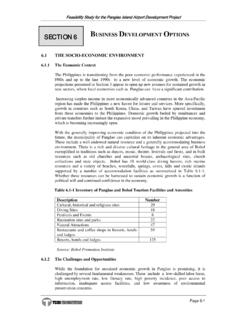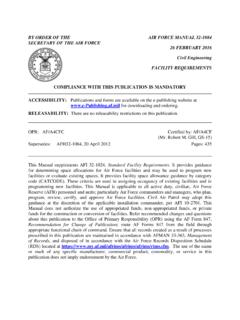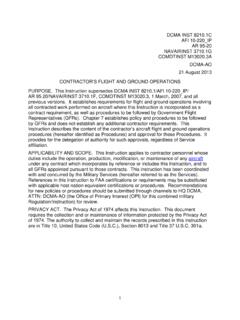Transcription of Physical Security Manual&Checklist
1 Rural & Small Town AirportPhysical Security Manual & ChecklistPrepared ByRobert A. Gardner, CPPT hrough a Grant from theWolf Aviation FundLicense StatementThe Rural & Small Town Airport Security Manual and Checklist is protected by United States Copyright Law. No part of this publication may be reproduced, stored in a retrieval system, or transmitted in any form or by any means, electronic, mechanical, photocopying, recording, or otherwise, without the prior written permission of Robert , CPP. You may not sell, rent, lease or transfer copies of the Rural & Small Town Airport Security Manual and Checklist in any way without the writtenpermission of Robert A.
2 Gardner, & Small Town Airport Security Manual and ChecklistCopyright 2002 by Robert A. Gardner, CPPUse and Reprint AuthorizationRobert A. Gardner, CPP authorizes the use of theRural & Small Town Airport Security Manual and Checklistby airport managers, airport users, airport and pilot associations, educational institutions and others concerned with Security at smallairports. The Rural & Small Town Airport Security Manual and Checklist may be copied and reprinted as necessary provided that such copies give full credit to both the author and Wolf Aviation Fund and are not sold or otherwise used for commercial or comments regarding this publication should be directed to:Robert A.
3 Gardner, CPPemail: Office:2620 Regatta Dr., Suite 102 Las Vegas, NV 89128702-733-8711 California Box 6880 Ventura, CA 93006805-659-4294 Funding for research and production of theRural & Small Town Airport Security Manual and Checklist was provided by the Wolf Aviation Fund through Grant No. W000612 AAlfred L. & Constance C. Wolf Aviation Fund Wolf, Block Schorr and Solis-Cohen1650 Arch Street, 22nd FloorPhiladelphia, Pennsylvania 19103-2097 Table of ContentsINTRODUCTION1 WHY BOTHER3 SMALL AIRPORTS AFTER 9/115A CRASH COURSE IN CRIME PREVENTION6 CRIME PREVENTION IN 3D8 CREATING A SECURE ENVIRONMENT10 SAMPLE Security STANDARDS15 PUTTING IT ALL TOGETHER31 CHECKLISTA-1 ABOUT THE AUTHORB-1 ABOUT WOLF AVIATION FUNDC-11 Chapter1 INTRODUCTIONMost of America s rural and small town airports were built at a time when Security and crime prevention were not issues.
4 Consequently, little or no effort was made to incorporate Security precautions into their design. This makes these facilities extremely vulnerable to modern , there are a variety of relatively simple and inexpensive steps that can be taken to increase the Security of airport facilities. Following the suggestion in this manual won t guarantee absolute Security , but it will give you a head start in protecting your airport and its manual is based on an earlier document developed for use by government facilities and businesses. It has been in use for a several yearsand has been well received by its manual is intended to function as an inspection and training instrument to enable you as a Small Airport Administrator or other responsible official to: Perform a Physical Security needs assessment of your facility (s) with regard to external Security threats Implement measures to address Security deficiencies identified in the of the manual include: An overview of general crime prevention theory.
5 This overview provides a basic understanding of criminal motivation and the goals and methods of crime prevention planning. A mostly non-technical discussion of Security design particular, it introduces the concept of Crime Prevention Through Environmental Design (CPTED) and explains the CPTED elements: D efensible Space, Territoriality, Surveillance, Lighting, Landscaping, and Physical A user-friendly set of design standards. These standards are based on a model developed by crime prevention and Security experts who are responsible for specifying Security requirements in new and renovated buildings. These standards are easily understandable guidelines for establishing a minimum level of adequate Security in every facility type.
6 This approach eliminates the need for the assessor to esta blish an arbitrary risk level for his or her facility . An annotated Assessment Checklist. This Checklist is modular in nature allowing assessors to address the potential risk areas present at their airport. Some airports may utilize every module. Most will only require a few modules. The focus of this checklist is the prevention of criminal attack on the airport from the Physical Security assessment utilizing the checklist should only be conducted after you have reviewed the information in this manual. Without a basic understanding of crime prevention theory and Security standards, it is difficult to accurately assess and evaluate Security risks.
7 After reviewing this manual and completing the assessment checklist, you will have a clear understanding of: Physical design factors influencing Security at your airport. Previously unidentified Security threats. The strengths and weaknesses of existing Security measures. Methods and procedures to eliminate or reduce Security Security is concerned, there are no absolute safeguards. There are however, proven crime prevention techniques that reduce the likelihood that criminals will view your airport, and its users, as attractive targets for understanding and acting on the information contained in this manual, you can significantly reduce the vulnerability of your airport to criminal using this manual and checklist, keep in mind that its purpose is not so much to tell you exactly what to do, but rather, to help you understand the concepts of Security and crime prevention.
8 By understanding these concepts, you are in a strong position to make the correct crime prevention BOTHERC rime rates in small towns and rural areas tend to be low, with serious crime a rare occurrence. Consequently, Security has never been a major concern at most rural and small town airports. These airports are generally used by a relatively small number of people who are well known to each other. Outsiders are rare and when they do arrive, their presence and activities are readily apparent to airport regulars. This familiarity and awareness leads to a trust that makes locks and fences seem unnecessary. Leaving offices, hangars and aircraft unsecured is , as population areas expand to encroach on previously remote airports, and criminals become more mobile and brazen, small airports are no longer immune from criminal activity.
9 Theft of avionics is on the rise everywhere. Theft of aircraft for drug smuggling and even terrorist activity is a growing threat. The fact that small airports are easily accessible and mostly unprotected is common knowledge in the aviation oriented criminal to accept this new reality and understand and address the crime risks that confront small airports can have devastating and financial implications to the owner for the theft of an aircraft or avionics are obvious. The potential implications for airport managementwhen an on-airport crime occurs can be less obvious but far more serious. Whenever a crime occurs on an airport there is a potential threat of litigation against its owners and managers.
10 If an on-airportcrime such as the theft of an aircraft ultimately results in injury or death to a third party at some other location, litigation is stolen aircraft crashed into a neighborhood during a drug run or into an office building during a terror incident can have far reaching repercussions for both the aircraft owner and the airport of of airport users can result in negative publicity and create economic losses for the airport and its FBO only way to avoid the consequences of crime and the potential litigation nightmares that follow is to make every reasonable effort to prevent any foreseeable criminal attack. This Security assessment is the first step in the Airports After 9/11On September 11, 2001, America suffered a devastating act of terrorism.







